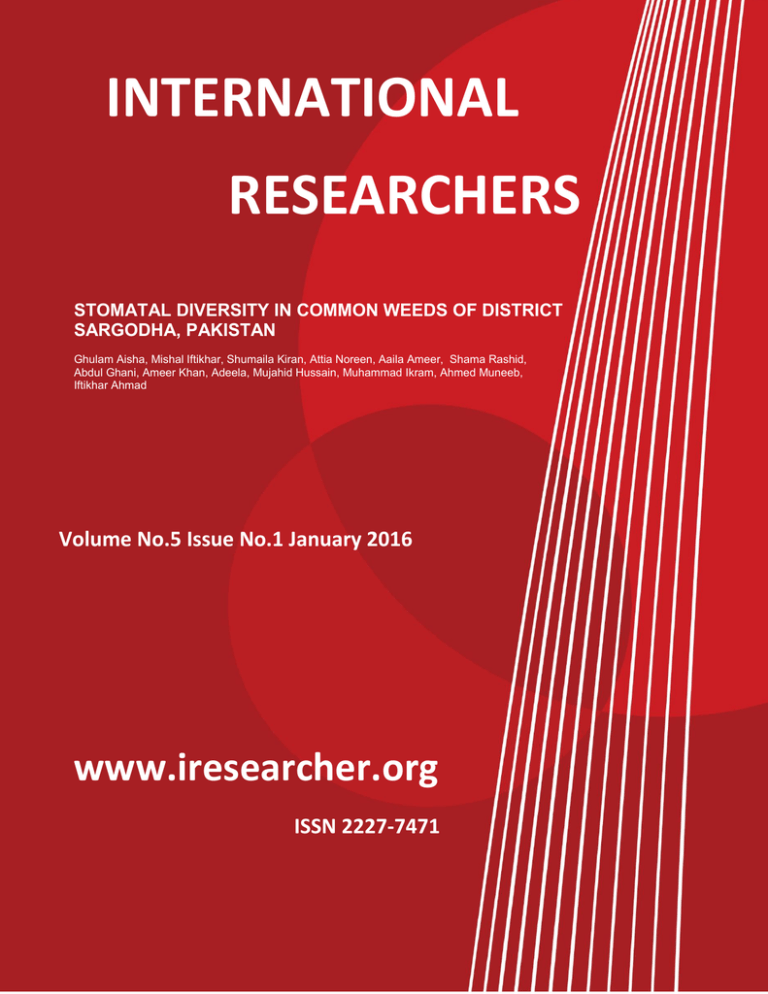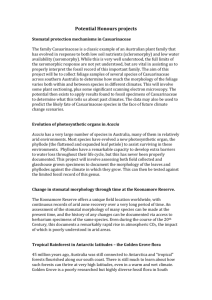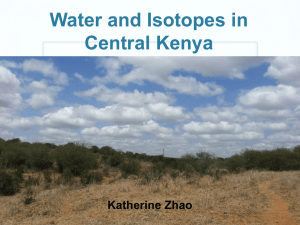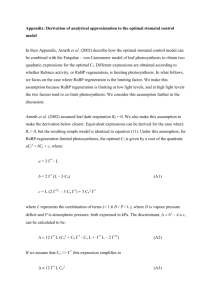
International Researchers Volume No.5 Issue No.1 January
INTERNATIONAL
INTERNATIONAL
RESEARCHERS
RESEARCHERS
2016
STOMATAL DIVERSITY IN COMMON WEEDS OF DISTRICT
SARGODHA, PAKISTAN
Ghulam Aisha, Mishal Iftikhar, Shumaila Kiran, Attia Noreen, Aaila Ameer, Shama Rashid,
Abdul Ghani, Ameer Khan, Adeela, Mujahid Hussain, Muhammad Ikram, Ahmed Muneeb,
Iftikhar Ahmad
Volume No.5 Issue No.1 January 2016
Page
ISSN 2227-7471
12
www.iresearcher.org
WWW.IRESEARCHER.ORG
=
www.iresearcher.org
International Researchers Volume No.5 Issue No.1 January
2016
THE INTERNATIONAL RESEARCH JOURNAL “INTERNATIONAL RESEACHERS”
www.iresearcher.org
© 2016 (individual papers), the author(s)
© 2016 (selection and editorial matter)
This publication is subject to that author (s) is (are) responsible for Plagiarism, the accuracy of citations, quotations,
diagrams, tables and maps. Corresponding author is responsible for the consent of other authors.
All rights reserved. Apart from fair dealing for the purposes of study, research, criticism or review as permitted under
the applicable copyright legislation, no part of this work may be reproduced by any process without written permission
from the publisher. For permissions and other inquiries, please contact
editor@iresearcher.org
INTERNATIONAL RESEARCHERS is peer-reviewed, supported by rigorous processes of criterion-referenced article
ranking and qualitative commentary, ensuring that only intellectual work of the greatest substance and highest
significance is published.
INTERNATIONAL RESEARCHERS is indexed in wellknown indexing diectories
with ICV value 5.90
Page
13
and moniter by
www.iresearcher.org
2016
International Researchers Volume No.5 Issue No.1 January
STOMATAL DIVERSITY IN COMMON WEEDS OF DISTRICT
SARGODHA, PAKISTAN
1
2
3
4
5
6
7
Ghulam Aisha , Mishal Iftikhar , Shumaila Kiran , Attia Noreen , Aaila Ameer , Shama Rashid , Abdul Ghani ,
8
9
10
11
12
Ameer Khan , Adeela , Mujahid Hussain , Muhammad Ikram , Ahmed Muneeb , Iftikhar Ahmad
1,2,3,4,5,6,7,8,9,10,11,12,13
13
Department of Botany, University of Sargodha, Sargodha, Pakistan
(PAKISTAN)
mishaliftikhar19@gmail.com
2
ABSTRACT
Weeds are equally important as other plant species. Being an integral part of our ecosystem, they along with
crops serve as food source in adverse kind of environments. Weeds develop different kinds of adaptations for their
survival in different stressed conditions. Epidermal appendages and stomata serve as first line of defence against
natural stresses. Present study was conducted to investigate the diversity of stomatal features of weeds collected
randomly from Sargodha district. From the weeds collected 10 distinct weed species with diverse kinds of stomatal
structure and shapes were selected. Weeds have different stomatal anatomy as some have paracytic and diacytic
type of stomata while others have compound type of stomatal anatomy as well. Morpho-anatomical data showed that
weeds in region Sargodha tend to have low stomatal density while higher stomatal length and width.
Keywords: Stomata, Diversity, Anomocytic, Paracytic, Diacytic
1.
INTRODUCTION
Weeds are defined as a plant out of place or growing where it is not wanted, flourishing in habitats disturbed by
humans, possessing competitive behaviour, and capable of mass movement from one area to another. Human
values related to disturbed and agricultural habitats, appearance, utility and biological traits dominate how we define
a plant as weedy (Dekker, 2011) . Since the leaf epidermal studies are considered important in phylogeny and
taxonomy. Attention of plant taxonomists has been attracted toward the leaf epidermal anatomical studies to resolve
the taxonomic problem and stomata are considered as a protection against extreme weather conditions. Region
Sargodha is saline, and in saline region Paracytic and anomocytic type of stomata are more frequently found (Das &
Ghose, 1993).
There are some reasons why we have great interest in stomata. Principal reason is that stomata are involved in the
control of two of the most important plant processes, namely photosynthesis and transpiration (Mansfield et al.,
1990). Stomata control 95 percent or more of the carbon dioxide and water vapour exchange between the leaf and
the atmosphere (Bunce, 2004). They therefore control rates of photosynthesis and transpiration by plants and since
photosynthesis is a major factor in determining rates of dry matter accumulation.
2.
MATERIALS AND METHODS
To unravel the stomatal anatomy of weeds, fresh weed specimens were collected from the region under study. After
careful identification and classification of leaf parts major taxonomical characteristics such as family name was
pinpointed. After that free hand peeling and nail paint methods was done to observe the leaf epidermis.
RESULTS AND DISCUSSION
Weeds are important part of flora have varying taxonomical and anatomical features. In the current study out of 11,
two plants belong to family Solanaceae. Weeds of Solanaceae family have been characterized as media for
www.iresearcher.org
Page
3.
14
Stained slides were prepared meticulously. To prepare stained slides of section of specimen, leaf was treated with
varied concentrations of the ethanol solution in a 10-15 minutes time interval, the concentrations of ethanol solution
treatment are as follow in time series manner: 30% , 60%, 50%. Afterwards in each leaf section 70% alcohol and 1
drop of safranin was added after a 10 minute interval. To remove the dye color, we washed our specimens with 90%
and 100% alcohol solution for the leaf part of each sample under observation to conduct the anatomical section study
by observing the epidermal appendages using high resolution microscope.
International Researchers Volume No.5 Issue No.1 January
2016
Cucumber mosaic virus infection in Southern Illinois (Hobbs et al., 2000) and other 1 each from other families
namely: Chenopodiaceae, Aizoaceae or Ficoidaceae, Euphorbiaceae, Cyperaceae, polygonacea, Asteraceae,
Convolvulaceae, Amaranthaceae, and Zygophyllaceae. Various types of stomata observed. On the basis of presence
of stomata on the leaf surface we found two distinct types of leaves were under examination namely: epistomatic
leaves (i.e. stomata occurring on the types of leaves adaxial surface only) and hypostomatic leaves (i.e. stomata
occurring on the abaxial surface only (Li et al., 2007; Metcalfe & Chalk, 1950). After careful observation 6 distinct
types of stomata mainly Paracytic, anomocytic, anisocytic, actinocytic, diacytic and staurocytic, while in some weeds
mixed stomatal type i.e., combination of two types was observed. Table 1 depicts the stomatal type. Paracytic,
staurocytic and anomocytic types of stomata are mostly observed in the weeds under examination. In the paracytic
type guard cells are accompanied by two subsidiary cells, the longitudinal axis of which is parallel to that of the guard
cells and aperture. The stomata types can be signalled out as being the most significant in relation to the taxonomic
separation of taxa. Anomocytic stomata are those in which the guard cells are not surrounded with any subsidiary cell
indicating that presence of subsidiary cells varies from weed to weed. Thus it can be deduced from the data that
paracytic, staurocytic and anomocytic stomatal type in weeds is more prominent in region Sargodha.
Stomatal density is one common measure of plant response to rising atmospheric carbon dioxide concentrations
(Royer, 2001). Based on the density of stomata, Sonchus asper has Anomocytic stomata having highest density on
upper and lower surfaces. But all other weeds under study have density upper stomatal upper and lower density up to
2
50 mm . Considering density in association to stomatal type, and leaves reflect significant differences in the weeds
under study. A higher value of stomatal density directly correlates to higher rate of photosynthetic activity of particular
plant and water conductance in plant (Schletz, 2008). However environmental factors also effect density of stomata.
In the current study the weeds taken as sample generally do not exhibit high upper and lower stomatal density. As
soil of Sargodha region is saline, thus lower density indicating low water conductance.
The stomatal size is parameter that is directly influences stomatal density. In the current study we found Sonchus
asper having higher density has smallest stomatal length both upper and lower indicating that it has large number of
stomata and their size is small. The data for stomatal length is in complete coherence with that of stomatal density. In
our study, all the weeds except Sonchus asper have low stomata density but have significantly high length of stomata
as compare to the density. Thus higher stomatal length is associated to reduced stomatal size (Drake et al., 2013).
350
300
250
200
150
100
50
0
Lower stomatal density
Page
Graph 1. Stomatal density on upper and lower surface of selected weed species
15
Upper stomatal density
www.iresearcher.org
International Researchers Volume No.5 Issue No.1 January
2016
40
35
30
25
20
15
10
5
0
Upper stomatal length
Lower stomatal length
Graph 2. Stomatal length on upper and lower surface of selected weed species.
In previous studies stomatal width and stomatal length are found to be positively correlated with each other while both
have negative correlation with stomatal density (Padoan et al., 2013). Our data shows an exception for Sonchus
asper.
50
45
40
35
30
25
20
15
10
5
Lower stomatal width
Graph 3. Stomatal width on upper and lower surface of selected weed species.
www.iresearcher.org
Page
Upper Stomatal Width
16
0
International Researchers Volume No.5 Issue No.1 January
Stomatal
Width in
micrometer
2016
Stomatal lengths in
micrometer
Stomatal Density
in mm2
Stomata Type
Upper
Lower
Upper
Lower
Upper
Lower
Chenopodium album
Staurocytic
17.9
17.9
9.2
9.2
35
38
Trianthema portulacastrum
Anomocytic & Aniosocytic
3.38
3.38
1.99
2.89
56
62
Croton bonplandianum
Paracytic
20
15
6
6
13
17
Cyperus rotundus
Paracytic
3.5
3.35
1.51
1.9
28
26
Rumex dentatus
Paracytic
22
15
31
32
45
54
Sonchus asper
Anomocytic
36
34
6
6
118
298
Withania coagulans
Anomotetracytic & Paracytic
56.1
38.5
38.3
17.3
12
18.5
Withania somnifera
Anomotetracytic & Anisocytic
12.5
24.8
25.6
13.5
14
20
Convovulus arvensis
Anomocytic
22.5
25
7.09
8.7
42
56
Amaranthus viridus
Staurocytic
6.5
12.41
14.5
17.4
16
9
Tribulubs terrestris
Actinocytic
17.5
18.5
20.25
21.5
132
112
Page
17
Specie Name
www.iresearcher.org
2016
Page
18
International Researchers Volume No.5 Issue No.1 January
www.iresearcher.org
International Researchers Volume No.5 Issue No.1 January
2016
Page
19
Figure 1. Comparative morpho-anatomical characteristics of (a) Tribulus terrestris, (b) Chenopodium album, (c)
Triantherma portulacastrum, (d) Croton bonplandianum, (e) Sonchus asper, (f) Cyperus rotundus, (g) Rumex
dandatus, (h) Parthenium hysterophorus and (i) Withania coagulans
www.iresearcher.org
International Researchers Volume No.5 Issue No.1 January
2016
References
Page
20
Bunce, J. A. (2004). Carbon dioxide effects on stomatal responses to the environment and water use by crops under
field conditions. Oecologia, 140(1), 1-10.
Das, S., & Ghose, M. (1993). Morphology of stomata and leaf hairs of some halophytes from Sundarbans, West
Bengal.
Dekker, J. (2011). Evolutionary ecology of weeds.
Drake, P. L., Froend, R. H., & Franks, P. J. (2013). Smaller, faster stomata: scaling of stomatal size, rate of response,
and stomatal conductance. Journal of Experimental Botany, 64(2), 495-505.
Hobbs, H., Eastburn, D., D'Arcy, C., Kindhart, J., Masiunas, J., Voegtlin, D., . . . McCoppin, N. (2000). Solanaceous
weeds as possible sources of Cucumber mosaic virus in Southern Illinois for aphid transmission to pepper.
Plant disease, 84(11), 1221-1224.
Li, Q., Yu, L.-j., Deng, Y., Li, W., Li, M.-t., & Cao, J.-h. (2007). Leaf epidermal characters of Lonicera japonica and
Lonicera confuse and their ecology adaptation. Journal of Forestry research, 18(2), 103-108.
Mansfield, T., Hetherington, A., & Atkinson, C. (1990). Some current aspects of stomatal physiology. Annual review of
plant biology, 41(1), 55-75.
Metcalfe, C. R., & Chalk, L. (1950). Anatomy of the dicotyledons, Vols. 1 & 2. Anatomy of the dicotyledons, Vols. 1 &
2.
Padoan, D., Mossad, A., Chiancone, B., Germana, M. A., & Khan, P. S. S. V. (2013). Ploidy levels in Citrus
clementine affects leaf morphology, stomatal density and water content. Theoretical and Experimental Plant
Physiology, 25(4), 283-290.
Royer, D. (2001). Stomatal density and stomatal index as indicators of paleoatmospheric CO 2 concentration. Review
of Palaeobotany and Palynology, 114(1), 1-28.
Schletz, R. (2008). Stomata densities of developing and mature leaves of Geraniums. ESSAI, 6(1), 42.
www.iresearcher.org





